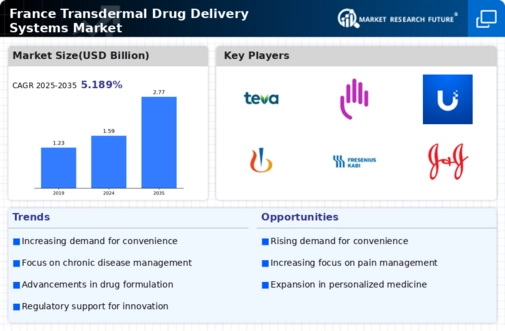Supportive Regulatory Environment
A supportive regulatory environment is fostering growth in the transdermal drug-delivery-systems market in France. Regulatory bodies are increasingly recognizing the importance of innovative drug delivery methods and are streamlining approval processes for transdermal products. This trend is likely to encourage pharmaceutical companies to invest in the development of new transdermal systems, as they can navigate the regulatory landscape more efficiently. Furthermore, the French government has been actively promoting initiatives aimed at enhancing healthcare innovation, which may further bolster the market. As a result, the transdermal drug-delivery-systems market is poised for growth, driven by a conducive regulatory framework that supports the introduction of novel therapies.
Growing Prevalence of Chronic Diseases
The increasing prevalence of chronic diseases in France is a significant driver for the transdermal drug-delivery-systems market. Conditions such as diabetes, hypertension, and chronic pain are becoming more common, necessitating effective and convenient treatment options. Transdermal systems offer a viable solution for managing these conditions, as they allow for continuous drug delivery and improved patient adherence. Recent statistics indicate that approximately 30% of the French population is affected by chronic diseases, underscoring the urgent need for innovative therapeutic approaches. Consequently, the transdermal drug-delivery-systems market is likely to expand as healthcare providers seek to implement more effective management strategies for these prevalent health issues.
Advancements in Formulation Technologies
Innovations in formulation technologies are playing a crucial role in shaping the transdermal drug-delivery-systems market in France. The development of novel polymers and enhancers has the potential to improve drug permeation and stability, thereby enhancing the efficacy of transdermal systems. For instance, the introduction of microneedle technology has shown promise in facilitating the delivery of larger molecules that were previously challenging to administer transdermally. This advancement could lead to a broader application of transdermal systems in treating chronic diseases, which is particularly relevant in the French healthcare landscape. As a result, the market is likely to witness increased investment in research and development, further propelling growth in this sector.
Increased Focus on Personalized Medicine
the transdermal drug delivery systems market in France is witnessing a shift to personalized medicine, emphasizing tailored treatment approaches based on individual patient needs. This trend is likely to enhance the appeal of transdermal systems, as they can be customized to deliver specific dosages and formulations that align with a patient's unique health profile. The integration of data analytics and patient feedback into treatment plans may further drive this trend, allowing for more precise and effective drug delivery. As the healthcare system in France continues to evolve towards personalized care, the transdermal drug-delivery-systems market is expected to benefit from this paradigm shift, potentially leading to improved patient outcomes.
Rising Demand for Non-Invasive Treatments
the transdermal drug delivery systems market in France is experiencing a significant increase in demand for non-invasive treatment options. Patients are increasingly favoring methods that minimize discomfort and reduce the need for injections. This shift is likely driven by a growing awareness of the benefits associated with transdermal systems, such as improved patient compliance and convenience. According to recent data, the market is projected to grow at a CAGR of approximately 8% over the next five years, reflecting the rising preference for these innovative delivery methods. As healthcare providers in France adapt to these changing patient preferences, the transdermal drug-delivery-systems market is expected to expand significantly, catering to a broader range of therapeutic areas.























Leave a Comment